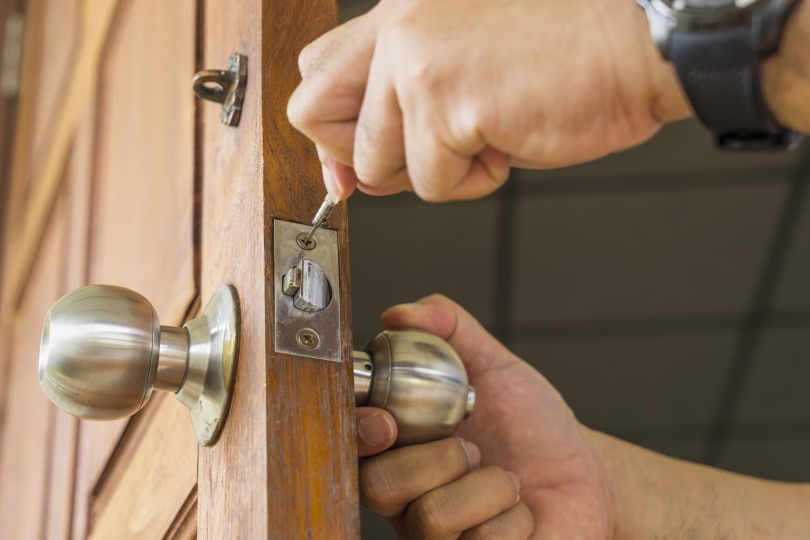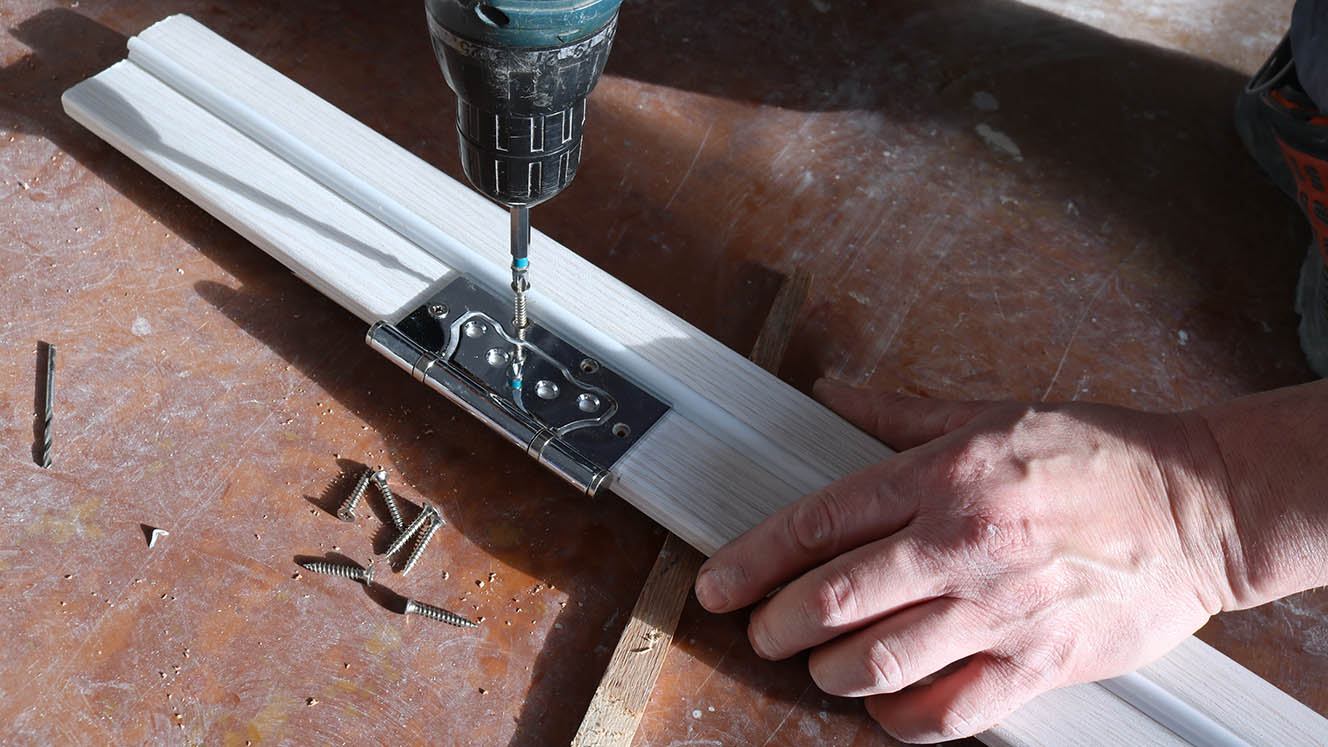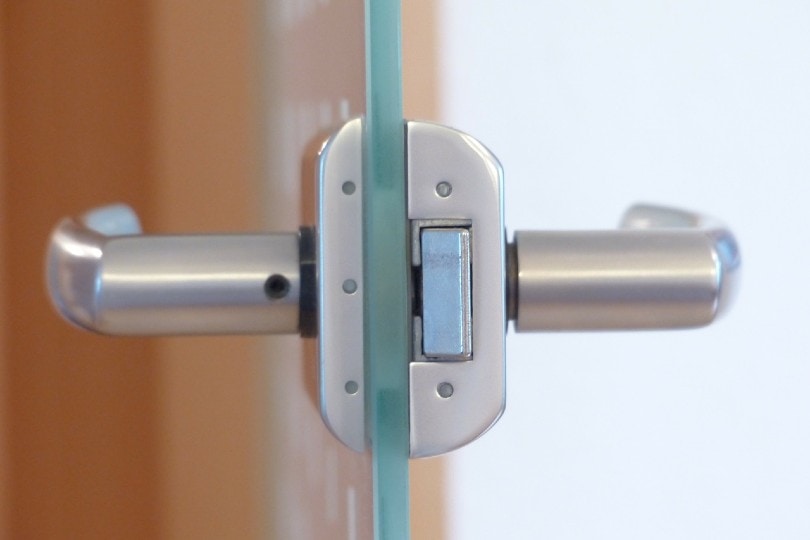How to Fix a Door That Won’t Latch in 10 Steps (with Pictures)
-

- Last updated:

Have you ever closed your front door but noticed it’s not latching well? The door closes, but when you grab the door handle and pull, it doesn’t feel like it’s closed all the way. You may not get a good night’s sleep until you get it fixed.
Perhaps it’s not a big deal if it’s a bedroom door., but imagine trying to close the front door of your home, and the issue of latching comes up. Whether your door is sticking out of alignment or the latch has broken off, it can ruin the security of your home. So, what do you do when you have a door that won’t latch? Read on to find out how to fix this common problem.

Safety Measures Before You Start
Ensuring your doors are in good working order is an excellent way to keep your home safe. Doors that won’t latch can be frustrating. However, you can fix them with the right tools.
- Ensure you have all the necessary tools to complete the job safely and efficiently.
- Before removing screws from a latch plate, take a photo of the plate and its alignment with the door jamb. It’ll make it easier to reassemble the hardware.
- Be aware of your surroundings and keep areas clear of obstructions.
- If you are using a hammer, wear safety glasses. Splinters of wood won’t get in your eyes if they fly off as you hit them with the hammer.
- If you’re using a drill, wear earplugs.
- Wear gloves and protective clothing.
Tools and Materials Needed
- Hand drill
- Chisel
- Philips-head screwdriver
- Putty knife
- Hammer
- Metal file
- Utility knife
- Wood filler
- Toothpicks
- Super Glue
Step-By-Step Guide for Fixing a Door That Won’t Latch
If your door doesn’t latch, the tips below will help. These steps will come in handy, from checking for obstructions to replacing the strike plate.
1. Diagnose the Issue
Start by determining what’s causing your door not to latch. Try shutting it firmly. If the door closes but doesn’t latch, it could be due to:
- Misaligned strike plate: This is the metal plate on the frame where the bolt extends when you close the door. If it’s misaligned with the bolt, it will prevent your door from latching.
- Sticking lock: There could be dust and debris in the lock, preventing it from moving well.
- Out of square: Your door might have shifted slightly out of place and can’t close all the way and latch well.
2. Assess the Hinges
Adjust the top hinge first by loosening the screws and pushing the hinge down. If that doesn’t work, pull the door out and remove some of the wood from the jamb. Be careful not to adjust this too much. You don’t want your door to be too wide or too narrow.
Adjusting the bottom hinge is a little more complicated than the top one. You may need to remove a portion of wood from both sides of your door or make adjustments with a screwdriver.
If these adjustments don’t work, remove the metal plates attached to the hinges on your door. Then, reinstall the metal plates in a different position on your door. Whichever method you choose, test it out by closing your door to see if the latch fits in the strike plate hole snugly.
3. Push the Strike Plate Downward
Sometimes, the problem is with the strike plate. The strike plate is the metal piece on the doorjamb against which the door latch or lock bolt extends when you close your door.
If shortening either part of your door’s hardware isn’t an option, try pushing down on the strike plate until it’s fully seated on the jamb. Loosen its screws slightly before adjusting it into place.
If loosening its screws doesn’t work, use a chisel and a hammer to fit against one corner of the strike plate until it aligns well with the jamb and latch bolt.
4. Enlarge the Hole in the Strike Plate
If the door won’t latch, it could be because the strike plate hole is too small for the latch. First, check if the latch is hitting any part of the strike plate other than its center. If so, you will need to enlarge that part of the hole.
Draw a line around this area with a pencil. This way, you can stay within it as your metal file wanders slightly. Enlarge the hole with a metal file. Insert it in the strike plate hole.
Then, move it back and forth as fast as you can on the strike plate’s lower lip. Get rid of as much metal as possible, depending on the latch. Enlarging the strike plate hole creates a hole sufficient for the latch to get through.
5. Position the Strike Plate Again
If you have tried the previous step, but your door won’t latch all the way, chances are the strike plate is out of alignment. If your door is a little older, it’s likely that the frame has settled slightly and moved out of alignment with the strike plate.
To reposition the strike plate, use a screwdriver to remove it from the frame. Drill new holes in the door frame and reposition the strike plate at a different angle.
6. Mark the New Position of the Strike Plate
Use a pencil to mark where you’ll drill the new hole. Make sure you mark it carefully so that you don’t end up drilling too close or too far away from the original position.
Now that you’ve marked where your new holes will go for your strike plate, you can drill them. Make sure that you’re using a drill that matches up with your screws.
Test if the strike plate fits in its new location before re-installing it using screws. Then, test-fit your door latch again to make sure it works smoothly.
7. Fill in the Old Screw Holes Using a Wood Filler
If you need to fill a deep hole, use a small piece of wood as support. Take your time, and don’t apply too much filler at one time since it shrinks as it dries. You can also add the wood filler to a putty knife and spread it over the old screw holes.
Allow it to dry completely. Once it dries, use sandpaper to sand down any excess wood filler. If your door is painted and you don’t plan on repainting it, use wood filler that is close in color to the old paint.
8. Prepare the Screw Holes

Use a countersink drill to avoid jagged edges if you have to drill your holes. Also, use a drill bit that is at least 1/8 inch smaller than the diameter of your screw to avoid splitting the wood. You can either use a drop of glue or drive in the screws.
If you use glue, put it in each hole, then drive in the screws. Ensure you drive them in so they are flush with the door’s surface.
9. Cut a New Lower Edge for the Strike Plate
Cut along the line you previously marked using a utility knife. You’re doing this to create room for the strike plate. It’ll form a gorge that can fit a chisel tip. Tap the chisel using a hammer, and ensure you point it into the gorge. It’ll loosen the piece of wood.
As soon as the piece of wood is out, form a clean wedge using a chisel. This is where the strike plate’s lower part will fit snugly. Then, inspect how the strike plate fits into place.
10. Install the Strike Plate into Place
You have finally made it to the last step! All that is left to do is put the strike plate back into position and put your screws in. After that, you are free to open and close your door!
Secure your new strike plate to the door jamb using screws that fit snugly into each pilot hole. Screw them in with your screwdriver or drill until tight and flush against the jam surface.
The 6 Common Causes Why Your Door Won’t Latch
Here are some of the most common reasons your door doesn’t latch.
1. The Strike Plate is Out of Alignment
The strike plate is a metal rectangle on the inside part of your doorframe where the latch meets when the door is closed. If this plate isn’t lined up with the hole in your doorframe well, the lock won’t catch in place.
2. A Broken Lock
If your lock is broken or missing parts, there is no way for it to catch onto anything when you close your door. If you have a broken lock, you’ll need to remove and replace it with a new one.
3. Loose Screws
If the door latch is not retracting, there may be loose screws. Check that the screws holding the strike plate in place are tight. If you’re having trouble fixing this yourself, call a professional for help.

4. Bent Door Jamb
If your door jamb is bent, it’ll need to be replaced by a professional locksmith or carpenter.
5. Latch Not Deep Enough
The latch on your deadbolt may not be caught into the strike plate on your door frame. It’s usually caused by wear and tear over time. If you’ve already adjusted the strike plate and tightened the screws, but it still doesn’t work, you need to replace your deadbolt with a longer one. That way, it can reach deeper into the strike plate.
6. Warped or Sagging Jambs or Header
If your jambs are warped or out of square with each other, you’ll have trouble getting your door to close and latch securely. Likewise, if you have a warped or sagging sill, your entire doorway may be out of the square. The sagging door sill may be caused by water damage.
How Does a Door Latch Work?
A typical door latch is a two-piece assembly. It’s a spring-loaded metal tongue that fits into a metal socket called a strike plate. A small bolt at one end of the assembly keeps the tongue in place and prevents the door from opening. It slides into a hole in the strike plate when the door is closed.
When you turn the doorknob or twist a lever handle, you rotate an L-shaped metal bar called a cam. It pulls the bolt back (or retracts) so it no longer holds the tongue in place. This allows you to open the door.

Purposes of a Strike Plate
There are two primary purposes of a strike plate. The first is to reinforce the door jamb where the latch or deadbolt lock bolts into it. The second is to provide a large surface area for the latch or deadbolt to bolt into. It increases resistance against forced entry (kicking in the door).
A regular door jamb is not strong, especially if made of wood and hollow inside. Usually, the strike plate is made of steel. It attaches directly to the jamb with 3-inch-long screws, substantially reinforcing it.
A standard strike plate will be about 2½ inches wide and 1⅛ inches tall. This provides much more area than just the lock cylinder.
Final Thoughts
It can be frustrating when your door won’t latch, but you don’t have to live with it. With a few simple tools and a little know-how, you can tackle the problem yourself. It’ll save you money over calling a professional.
Remember, there are several causes of a door latch malfunctioning. So, if your door isn’t latching like it’s supposed to, check out the first step for more information on what you might be facing. Hopefully, these instructions have come in handy, and you can fix your door latch.
Featured Image Credit: Kawin Ounprasertsuk, Shutterstock
Contents



